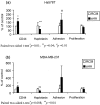Effects of hyaluronan on the invasive properties of human breast cancer cells in vitro
- PMID: 11488992
- PMCID: PMC2517708
- DOI: 10.1046/j.1365-2613.2001.iep0082-0193-x
Effects of hyaluronan on the invasive properties of human breast cancer cells in vitro
Abstract
Hyaluronan (HA) is a high molecular weight glycosaminoglycan present mostly in the extracellular matrix (ECM). HA binds to specific receptors such as CD44. Its production is increased at the tumour-stroma interface, including those in breast cancer tumours. It has been suggested that it facilitates invasion of tumour cells into the ECM by a hydrodynamic effect, or by altering tumour cell behaviour. Using in vitro tests we studied the effect of immobilized (iHA) and soluble (sHA) HA on the invasive properties of four human breast cancer cell lines with different levels of CD44 expression. Our results show that iHA acts as an adhesive, haptotactic, and motility stimulating factor for the CD44 positive Hs578T cells and induces the expression of membrane CD44. sHA also changes the motility properties of the Hs578T and MDA-231 cells and increases their CD44 expression. sHA or iHA have no measurable effect on the adhesion, motility or CD44 expression of the ZR-75-1 and MCF-7 breast cancer cells. Our results establish that in high CD44 expressing breast cancer cells HA modulates tumour cell adhesion and motility and also increases the expression of its own receptor, CD44.
Figures






Similar articles
-
Role of CD44s and CD44v6 on human breast cancer cell adhesion, migration, and invasion.Exp Mol Pathol. 2009 Apr;86(2):95-100. doi: 10.1016/j.yexmp.2008.12.003. Epub 2009 Jan 6. Exp Mol Pathol. 2009. PMID: 19167378
-
CD44-mediated adhesion to hyaluronic acid contributes to mechanosensing and invasive motility.Mol Cancer Res. 2014 Oct;12(10):1416-29. doi: 10.1158/1541-7786.MCR-13-0629. Epub 2014 Jun 24. Mol Cancer Res. 2014. PMID: 24962319 Free PMC article.
-
Molecular weight specific impact of soluble and immobilized hyaluronan on CD44 expressing melanoma cells in 3D collagen matrices.Acta Biomater. 2017 Mar 1;50:259-270. doi: 10.1016/j.actbio.2016.12.026. Epub 2016 Dec 10. Acta Biomater. 2017. PMID: 27965172
-
CD44 and hyaluronan binding by human myeloid cells.Leuk Lymphoma. 1996 May;21(5-6):407-20, color plates following 528. doi: 10.3109/10428199609093438. Leuk Lymphoma. 1996. PMID: 9172805 Review.
-
Activation of Matrix Hyaluronan-Mediated CD44 Signaling, Epigenetic Regulation and Chemoresistance in Head and Neck Cancer Stem Cells.Int J Mol Sci. 2017 Aug 24;18(9):1849. doi: 10.3390/ijms18091849. Int J Mol Sci. 2017. PMID: 28837080 Free PMC article. Review.
Cited by
-
Role of receptor for hyaluronic acid-mediated motility (RHAMM) in low molecular weight hyaluronan (LMWHA)-mediated fibrosarcoma cell adhesion.J Biol Chem. 2011 Nov 4;286(44):38509-38520. doi: 10.1074/jbc.M111.275875. Epub 2011 Sep 13. J Biol Chem. 2011. PMID: 21914806 Free PMC article.
-
A Step Forward in Breast Cancer Research: From a Natural-Like Experimental Model to a Preliminary Photothermal Approach.Int J Mol Sci. 2020 Dec 18;21(24):9681. doi: 10.3390/ijms21249681. Int J Mol Sci. 2020. PMID: 33353068 Free PMC article.
-
Virtual screening-driven repositioning of etoposide as CD44 antagonist in breast cancer cells.Oncotarget. 2016 Apr 26;7(17):23772-84. doi: 10.18632/oncotarget.8180. Oncotarget. 2016. PMID: 27009862 Free PMC article.
-
Preparation and Characterization of Collagen-Hyaluronic Acid (Col-HA) Matrices: In Vitro Mimics of the Tumor Microenvironment.Methods Mol Biol. 2024;2747:131-139. doi: 10.1007/978-1-0716-3589-6_11. Methods Mol Biol. 2024. PMID: 38038937
-
Hyaluronic acid in digestive cancers.J Cancer Res Clin Oncol. 2017 Jan;143(1):1-16. doi: 10.1007/s00432-016-2213-5. Epub 2016 Aug 17. J Cancer Res Clin Oncol. 2017. PMID: 27535565 Free PMC article. Review.
References
-
- Aruffo A, Stamenkovic IMM, Underhill CB, Seed B. CD44 is the principal cell surface receptor for hyaluronate. Cell. 1990;61:1303–1313. - PubMed
-
- Bae SN, Arand G, Azzam H, et al. Molecular and cellular analysis of basement membrane invasion by human breast cancer cells in Matrigel-based in vitro assays. Breast Cancer ResTreat. 1993;24:241–255. - PubMed
-
- Bertrand P, Girard N, Delpech B, Duval C, d'Anjou J, Dauce JP. Hyaluronan (hyaluronic acid) and hyaluronectin in the extracellular matrix of human breast carcinomas: comparison between invasive and non- invasive areas. Int. J. Cancer. 1992;52:1–6. - PubMed
-
- Boyce DE, Thomas A, Hart J, Moore K, Harding K. Hyaluronic acid induces tumour necrosis factor-alpha production by human macrophages in vitro. Br. J. Plast. Surg. 1997;50:362–368. - PubMed
-
- Culty M, Shizari M, Thompson EW, Underhill CB. Binding and degradation of hyaluronan by human breast cancer cell lines expressing different forms of CD44: correlation with invasive potential. J. Cell Physiol. 1994;160:275–286. - PubMed
Publication types
MeSH terms
Substances
LinkOut - more resources
Full Text Sources
Other Literature Sources
Medical
Miscellaneous

